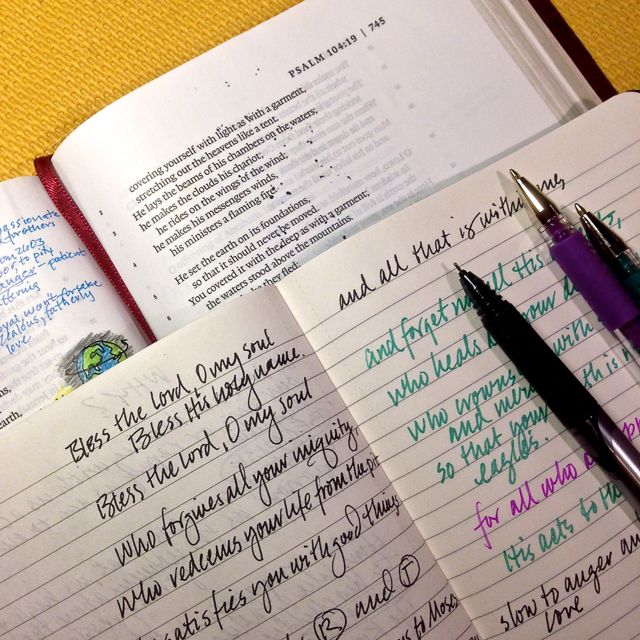Image may be NSFW.
Clik here to view.
Tomorrow we’ll go back to the “fors” we circled on Day 22. But today we’re going to take a few minutes to look at how Psalm 103 is written.
The psalms are poems that were written to be sung. Hebrew poetry is different than English poetry. Hebrew and English poetry both use meter to give a rhythm to the words, but it’s not apparent to us when we read the psalms, since we’re not reading them in Hebrew. Hebrew poetry does not use rhyme, as many English poems do. Instead it employs another poetic form called parallelism.
When using parallelism, the writer expresses a thought in the first phrase of a sentence, and then expresses a related thought in the second phrase.
Sometimes the second phrase contrasts with the first (contrastive). “A soft answer turns away wrath, but a harsh word stirs up anger.”
Sometimes it makes a comparison with the first (comparative). “Like a gold ring or an ornament of gold is a wise reprover to a listening ear.”
Often it restates the first thought in a slightly different way (completive). “A false witness will not go unpunished, and he who breathes out lies will perish.”
We’ve recently looked at several verses in Psalm 103 that use comparative parallelism. Do you remember looking for as/so phrases and the word like on Day 20? If you go back and look again at those verses in the psalm, you’ll see that each verse is composed of two phrases that liken one thing to another.
Most of Psalm 103 employs completive parallelism. We aren’t going to go into a great deal of detail about the different types of completive parallelism. But paying attention to this poetic device as you read the psalm today will add a new understanding and appreciation of its beauty. Noticing the parallelism can also help us as we memorize the psalm. (If you want to know more details, you can read this lesson from our Proverbs 31 study.)
Assignment: Pray for the Holy Spirit’s guidance and teaching as you study today. Then read all of Psalm 103, paying special attention to the structure of each verse. Notice (and appreciate) the almost echo-like quality as one thought is expressed and then repeated again with different words.
Think about the repetition. Are the two phrases saying the same thing in different ways? Is the second phrase adding to the meaning of the first? Is the second phrase completing the meaning of the first? Are comparisons being made? Don’t worry about assigning a particular type of parallelism to each verse. Just pay attention and enjoy.
The opening verse of the psalm has a longer phrase length than the verses that follow. Watch for the other two interruptions of the two-phrase parallel structure. What is being said in the two longer verses that break this pattern? Do you think David lengthened the phrases in these verses for a purpose?
It’s also interesting to note that the verses with comparative parallelism are all located in center of the psalm, sandwiched between a lot of completive parallelism. Something to ponder . . .
When you’ve finished reading and watching for parallelism, read the psalm one more time, and just enjoy. Bask in its beauty and comfort.
If you’re still working on memorizing the psalm, consider copying the psalm with a space (or tab) between the two phrases of each verse. This might help you more easily remember the related phrases. I know that for me, having a visual arrangement where I can see small portions of the psalm at a time, helps me remember each phrase more easily.
Bless the Lord, O my soul, and forget not all His benefits,
Who forgives all your iniquity, who heals all your diseases,
Who redeems your life from the pit, who crowns you with steadfast love and
mercy
For your children:
Divide into two groups. Then recite as much of the psalm as you can, with one group saying the first phrase of each verse, and the other group saying the second phrase. When you have finished, change roles. Recite the opposite phrase you recited the first time.
If your children are old enough to understand, show them how the second phrase of each verse often expands or repeats the meaning of the first phrase. (You could use your puzzle pieces from Day 7 to help show this.)